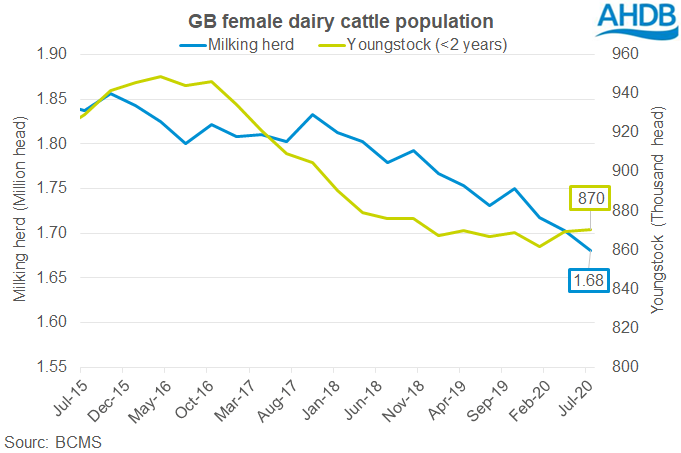GB milking herd shrinks as producers look to curb production
Wednesday, 19 August 2020
By Felicity Rusk
The GB milking herd has continued to shrink, according to the latest data from BCMS. As at 1 July, there was a total of 1.68 million dairy cows in the GB milking herd. This is a 2.9% reduction compared to the same point in the previous year, the equivalent of 51,000 cows. This annual reduction is significantly higher than the 3-year average (-1.3%) for July, but is in line with what we have seen in the herd since January 2019.

However, it is notable that the number of youngstock (under two years) has actually risen on the year. While the increase is relatively small, at 0.4%, it is the first time the number of youngstock has risen year-on-year since October 2016. This is not surprising since we saw an uplift in the number of dairy females born in 2019, which has continued into this year. This suggests that we may see some stabilisation in the dairy herd from 2021 onwards.
Impact of coronavirus
With the challenges that 2020 has brought to many dairy farmers, we have seen some interesting changes in the profile of the milking herd between April and July.
Relative to the three-year average (2017-19) change, we saw a larger decline in the number of cows of all categories aged over 4 years. There was a particularly notable drop in the number of cows aged 8+ years, which recorded a 2% decline this year, which is almost double that of the 3-year average. Furthermore, there was a larger drop in cows aged 4-6 years (-1.5%) than the three-year average (-1.0%).
.png)
We estimate that almost a quarter of GB dairy producers were faced with reducing their milk output from April, as a result of the pandemic. As such, these larger drops in the older half of the milking herd suggest that some producers opted to employ a harder culling policy in order to rapidly curb production.
Cull cow markets prices are almost 40p ahead of the 5-year average, which could provide an incentive for dairy producers to continue to use a harder policy in the coming months. However, with milk production now back in line with pre-COVID expectations, in order to maintain volumes, any reduction in the size of the milking herd would have to be compensated by an equivalent rise in yields.
Sign up to receive the latest information from AHDB.
While AHDB seeks to ensure that the information contained on this webpage is accurate at the time of publication, no warranty is given in respect of the information and data provided. You are responsible for how you use the information. To the maximum extent permitted by law, AHDB accepts no liability for loss, damage or injury howsoever caused or suffered (including that caused by negligence) directly or indirectly in relation to the information or data provided in this publication.
All intellectual property rights in the information and data on this webpage belong to or are licensed by AHDB. You are authorised to use such information for your internal business purposes only and you must not provide this information to any other third parties, including further publication of the information, or for commercial gain in any way whatsoever without the prior written permission of AHDB for each third party disclosure, publication or commercial arrangement. For more information, please see our Terms of Use and Privacy Notice or contact the Director of Corporate Affairs at info@ahdb.org.uk © Agriculture and Horticulture Development Board. All rights reserved.

